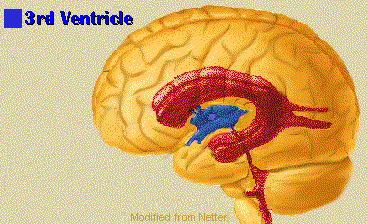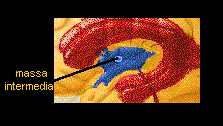

The Third Ventricle
 The
third ventricle (in
blue) is a narrow vertical cleft between the 2 lateral ventricles. It possesses
a roof, a floor and four walls: anterior, posterior and two lateral. The
roof is formed by the tela choroidea.
The
third ventricle (in
blue) is a narrow vertical cleft between the 2 lateral ventricles. It possesses
a roof, a floor and four walls: anterior, posterior and two lateral. The
roof is formed by the tela choroidea.
The floor is made up of the optic chiasm, the tuber cinereum and the infundibulum, the mamilary bodies, the posterior perforated substance and the upermost part of the mesencephalic tegmentum. The anterior wall is the delicate lamina terminalis. The short posterior wall is formed by the stalk of the pineal gland and the habenular commissures.
|
|
The roof of the third ventricle is formed by a thin layer of ependyma. The lateral walls are formed mainly by the medial surfaces of the 2 thalami.The lower lateral wall and the floor of the ventricle are formed by the hypothalamus and subthalamus. |
 The
massa intermedia
is a band of gray matter which crosses the cavity of the ventricle joining
the external walls.
The
massa intermedia
is a band of gray matter which crosses the cavity of the ventricle joining
the external walls.
The following structures may be found in the floor of the third ventricle (from anterior to posterior end): optic chiasm, infundibulum, tuber cinereum, mammilary bodies, and subthalamus.
Three openings communicate with the third ventricle: the two ventricular foramens at the anterior end communicate with the lateral ventricles, and the cerebral aqueduct (aqueduct of Sylvius) opens in the caudal end of the third ventricle.
 The
interventricular foramen (foramen de Monro)
is an oval aperture between the column of the fornix and the anterior end
of the thalamus through which the lateral ventricles communicates with
the third ventricle. The third ventricle also communicates with the fourth
ventricle through the narrow cerebral (sylvian or mesencephalic) aqueduct.
The short interthalamic adesion (massa intermedia) bridges the narrow ventricular
space.
The
interventricular foramen (foramen de Monro)
is an oval aperture between the column of the fornix and the anterior end
of the thalamus through which the lateral ventricles communicates with
the third ventricle. The third ventricle also communicates with the fourth
ventricle through the narrow cerebral (sylvian or mesencephalic) aqueduct.
The short interthalamic adesion (massa intermedia) bridges the narrow ventricular
space.
Author: Silvia Helena Cardoso, PhD. Psychobiologist, master and doctor in Sciences by the University of São Paulo and post doctoral fellowship by the University of California, Los Angeles. Invited Professor and Associate Researcher of the Center for Biomedical Inofrmatics, State University of Campinas (Unicamp), Brazil.
Reviewed and commented by the neuroanatomist Dr. Norberto Cysne Coimbra , MD, PhD. Neuoanatomist, Neuroscientist, Molecular Biologist. Laboratory of Neuroanatomy and Neuropsichobiology, Department of Morphology, Faculty of Medicine, Ribeirão-Preto USP (São Paulo), Brazil.
Translation: Silvia Helena Cardoso
Center for
Biomedical Informatics
State University of Campinas, Brazil
Silvia
Helena Cardoso, PhD
Editor-in-Chief
Copyright 1997 Universidade Estadual de
Campinas
ISSN 1414-4018